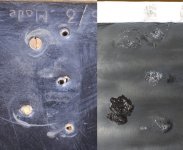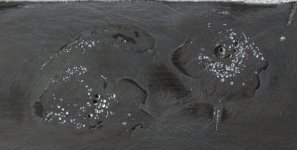Hiya Folks,
I've started messing around with repairing celluloid, and it's quite fun so far
Here's part of my 1950's Scandalli that somebody drilled 5 holes in before and after filling the screw holes:

I epoxied the holes from the inside which reduced the air leakage quite a lot.
Then I applied celluloid dissolved in acetone and waited 24 hours and wet sanded it with 600 grit wet/dry paper.
The problem is I'm getting pits in the new celluloid.
I tried repeating the process and the same thing happened, here's a closeup:

That's after I wiped it with IPA so I think the whiteness of the pits is just the lighting.
Anybody know what I'm doing wrong ?
It's possible my celluloid mix is too thick so I'm trying some thinner mix at the moment.
I've started messing around with repairing celluloid, and it's quite fun so far
Here's part of my 1950's Scandalli that somebody drilled 5 holes in before and after filling the screw holes:

I epoxied the holes from the inside which reduced the air leakage quite a lot.
Then I applied celluloid dissolved in acetone and waited 24 hours and wet sanded it with 600 grit wet/dry paper.
The problem is I'm getting pits in the new celluloid.
I tried repeating the process and the same thing happened, here's a closeup:

That's after I wiped it with IPA so I think the whiteness of the pits is just the lighting.
Anybody know what I'm doing wrong ?
It's possible my celluloid mix is too thick so I'm trying some thinner mix at the moment.
